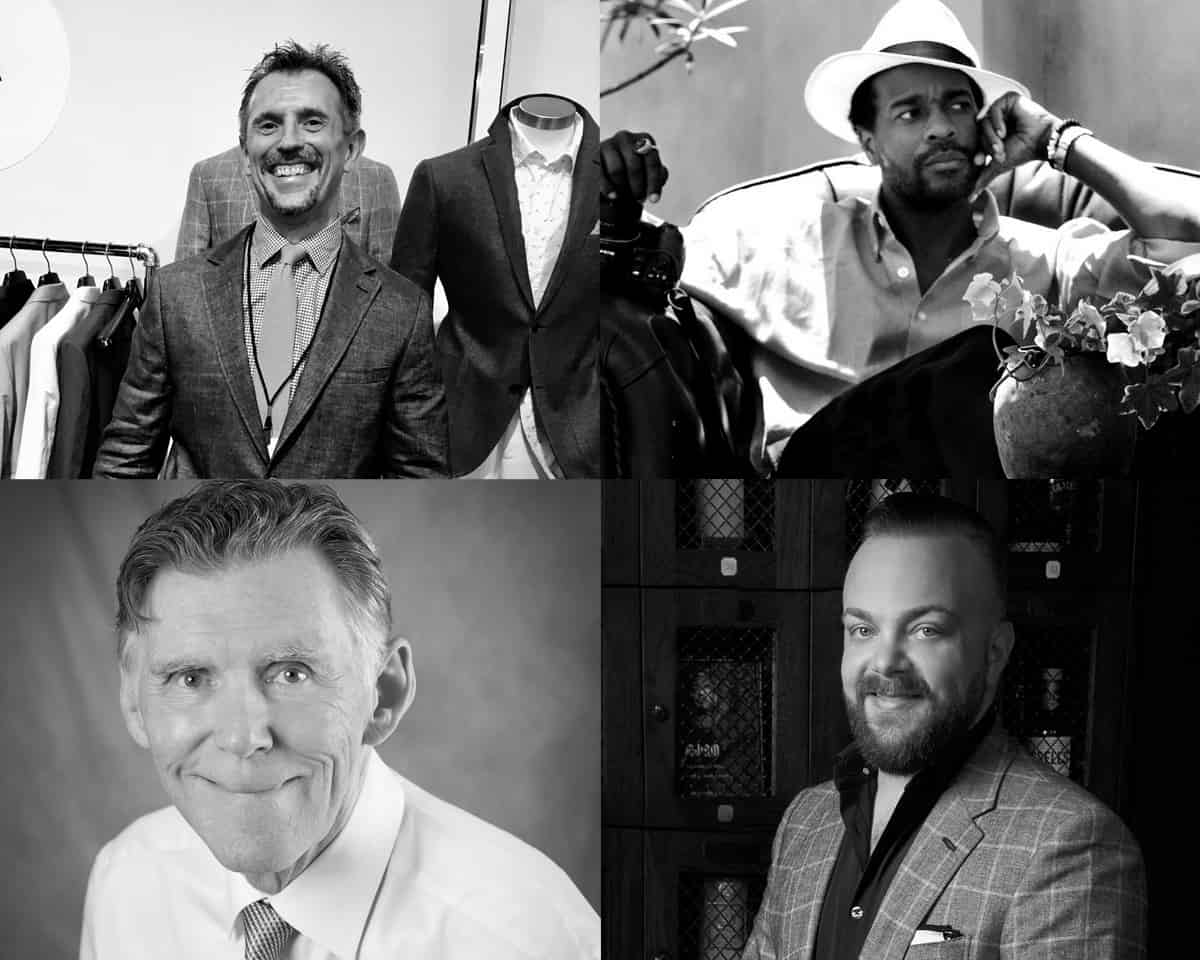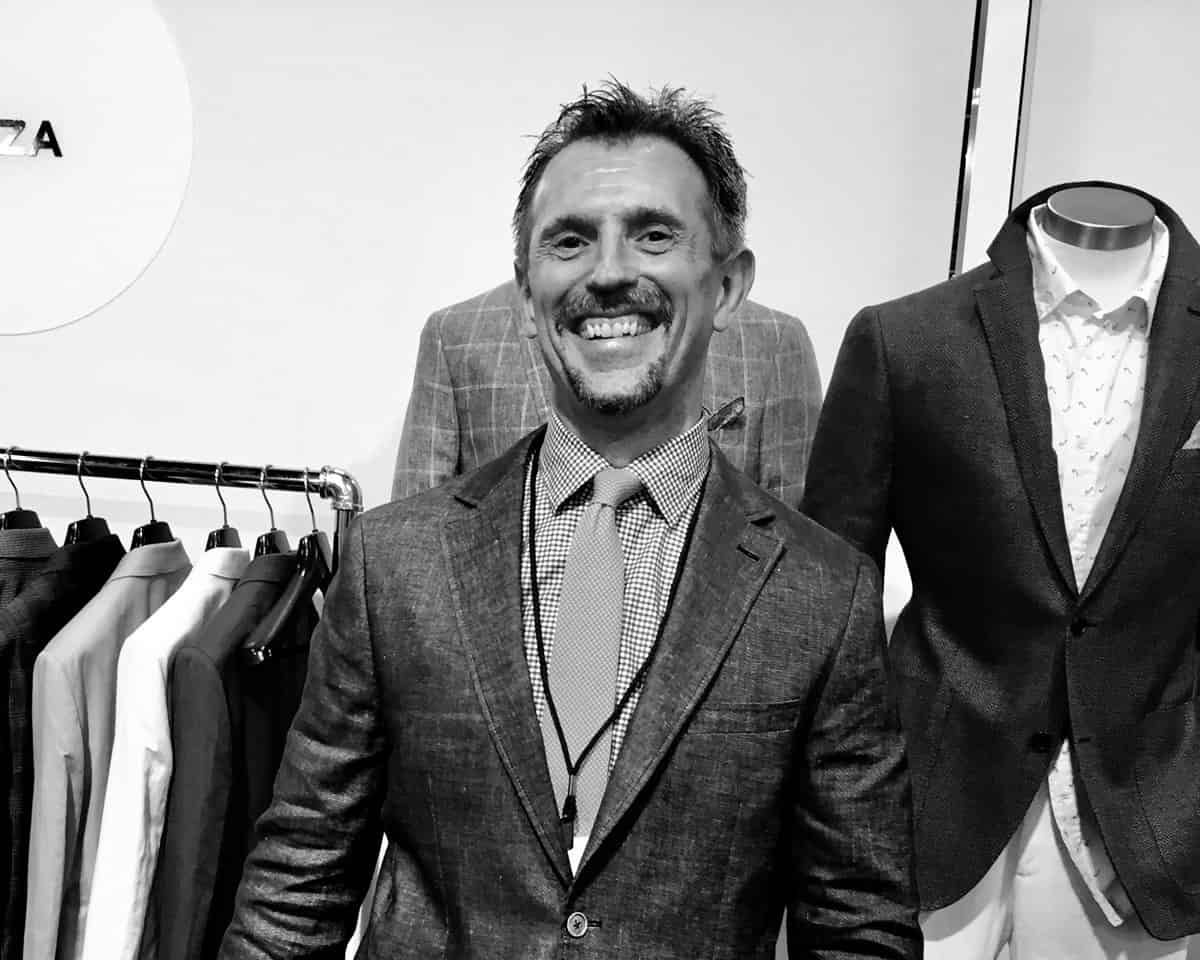EXPERT INSIGHTS FROM MR’S ADVISORY BOARD

A recent MR Advisory Board gathering uncovered some interesting insights into the present state of menswear, key challenges/opportunities and what’s next in men’s fashion. Here, a few excerpts from our conversation with half of our advisory team. (Part 2 soon!)
Al Leinen, Halls Kansas City: Business is holding up nicely. There are pockets where we detect a bit of a slowdown, but overall, customers who have money are still spending it. For the rest, I mean, there are certain things you’ve got to buy before clothing: gas and groceries, for example. But I still think holiday will be pretty strong.
Sam Glaser, Stitched Las Vegas: The excitement for us is the strength of our recently opened suburban store in Summerlin. We did this deal in June 2020 during the pandemic when the Vegas strip closed for three months. It was essentially a hedge against a prolonged closure; we called it a pop-up shop and kept extending the lease a year at a time. It’s pretty modest compared to our store in the Cosmopolitan hotel but we brought over all our hallmark furnishings: the red leather couches, brick walls, distressed floors. And it’s done surprisingly well.
“We keep planning conservatively and our clients keep reporting increases.” Steve Pruitt, Blacks Retail
Steve Pruitt, Blacks: The most exciting thing for us is that all our luxury-based clients are experiencing exceptionally strong business. Every time I open the newspaper, it seems as if business is about to go to hell in a hand basket. So we swing back and forth between it’s going to be great and it’s going to be terrible. What do I believe? Since it’s impossible to really know, we keep planning conservatively while our clients keep reporting increases. Of course, the most challenging part is knowing when to pull back. How long can these double-digit increases go on? I mean you read the Wall Street Journal and all the major bankers say this will not be a soft landing. But luxury customers are thinking, “Who cares? We have plenty of money. Interest rates going back up? Let them! I make money on interest…”
Leinen: I’m most excited about our made-to-measure business: it’s been strong for several seasons and remains unbelievable (close to 30 percent of our total clothing sales). The number of clients who show up for these trunk shows and MTM events amazes me. Our Zegna event, which is our number one trunk show, doubled our largest event ever. Of course, the hard part is the follow-up: production and shipping are still problematic. We’re already far into our fall season, and many vendors are struggling to get us fall goods. So that’s the most challenging thing for us, especially going into the holidays.
Will vendors take goods back if they arrive past shipping date?
“If we had more goods, we’d be doing more business.” Al Leinen, Halls Kansas City
Leinen: Most are pretty good partners, and work with us to come up with solutions. But the way business has been going lately, if we had more goods, we’d be doing more business. But maybe, as Steve said, not being over-inventoried is a good strategy in these precarious times.
Glaser: Our business at the Cosmopolitan is about 20 percent custom clothing, and growing in a healthy way. The most exciting part is a couple of brand extensions into women’s custom clothing. It’s such an underserved market, and we’ve become pretty good at it. We’ve also expanded into footwear, where business is really gaining traction. At our Cosmopolitan store, we can sell really wild footwear: hot blue, python… Guys are wearing $500 sneakers with their suits. We’re also doing more in the elevated leisure space, making really cool tech bomber jackets and the like. So business has been fun! Our main challenge now: we’re aggressively trying to add a second Vegas location, but the retail real estate market is tight.
“The key to selling fashion is telling the story behind the brand.” Karl-Edwin Guerre, No Chaser
Karl-Edwin Guerre, founder, No Chaser magazine: The most exciting part of my job these days is discovering brands. I just had a meeting with a 100-year-old brand out of Canada that I’d never heard of! I think the key to selling fashion these days is the story behind the brand. Especially coming out of Covid, people want to see and hear a story that connects them to the product, and the brand. So what I’m trying to do with No Chaser is cater to a specific community–the specialty shops that speak the same language we do–before we expand to the masses. For me, it’s about separating luxury from lifestyle. I want to help redefine some of those terms, because most new fashion brands are NOT necessarily selling luxury product.
I’m also the guy going against the grain with long features in a print magazine. While most would say people’s attention spans these days are about ten seconds, I want to prove that’s not true. Give them something interesting to read and I believe they’ll pay attention.
It’s also about navigating through the social media mindset and that wave of wanting to be seen by everybody vs. focusing on/catering to those that really see you. That’s where I’m at right now. Instead of worrying about getting a hundred thousand followers, why not capture the five thousand you already have?
In terms of marketing, I believe what heritage brands need to do is find the old stories that were always the DNA of the brand and communicate these to a new audience in a new way. We need to show how the brand has shifted to stay relevant, how it’s been modernized.
Leinen: But how do you make that story appeal to today’s customer? Because things always come around again, whether it’s a slim or slouchy suit, a skinny or wide tie, these things inevitably make a 360 turnaround and come back but in a new way. The challenge is to make an old look seem relevant to today’s customer, to make him understand why classic looks that were once important are worth learning about.
Because we’re still dealing with supply chain issues, many stores are placing orders earlier. Is this a smart strategy?
Pruitt: Just because you placed orders earlier doesn’t mean the goods will come in earlier, or even when you need them. But the problem is, retailers don’t have control. If there are no buttons available or no shoulder pads, the vendors can’t ship a suit. So the pandemic caused some real problems. But in big stores, there’s a contract: if the goods don’t arrive, there’s a financial penalty. And while this should theoretically work for independents (why should accept goods floating around, not knowing where they are or when they’ll show up), few specialty stores have that kind of clout with the vendors…
That said, if retailers understand upfront what vendors can and can’t do, they can establish a relationship so it’s done correctly. I work with some smaller retailers, 2- to 3- million dollar stores, who control their deliveries within a given window. Their vendors never ship without pre-authorization, and they have better sales as a result.
I’ve heard so many retailers complain that their vendors are not communicating with them lately…
Pruitt: I believe the job of the vendor is to make beautiful, saleable merchandise. The job of the retailer is everything else. So it’s up to the retailers to be in close contact with their brands.
Glaser: Put it that way and I don’t know why anyone would ever be a retailer… But I agree. At Stitch, we impose restrictions and shipping windows, and we’re constantly negotiating discounts for tardiness. So it works out okay.
Leinen: If you’re a good customer, vendors will bend over backwards to get you goods on time, and do whatever it takes to continue doing business with you. But where we could definitely use a little help from the market is with basics. That’s the component that really got messed up over the past year, and to me the most important part of the business. We need to get it straightened out because whether it’s a blue suit, gray suit, black tux, or white dress shirt, those are the things we need year-round.
Could we turn for a minute to e-commerce. MR just called out 2023 as The Year of the Independent Specialty Store, many of whom do no online business at all…
“At Stitched, we turn creative dreams into beautiful custom clothing.” Sam Glaser, Stitched
Glaser: I don’t mean to be the contrarian, but I think by and large that the Internet is the greatest threat to independent retailers. I spend a lot of time thinking about what we can do about it. To me, it’s all about delivering a unique in-store experience, one that’s not replicable online. And I think those independent stores that will survive are the ones doing something really special. In our store, it’s our Liquor Lounge that we’ve created for our VIP customers. It’s become a pretty cool place to relax, have a cocktail, bump into interesting people, and often to shop. Customers come with friends and there’s this viral effect that happens, especially in the custom part of the business. They actually help design the clothing! We like to say we turn creative dreams into beautiful clothing. And these are the kinds of experiences the Internet’s never going to replicate. So I think that yes, the Internet’s a huge threat to our industry but we can respond by delivering unique experiences.
What is everyone’s crystal ball on men’s fashion…
Glaser: Based on changing weather patterns, especially in Vegas, I’m buying more and more seasonless product that can sell year-round. People want clothes that are not constrained by weather. Even colors are starting to bleed through the seasons: our fall/holiday look book is full of lavenders and baby blues, spring shades but in mid-weight fall fabrics.
Leinen: My personal feeling is that men’s apparel is starting to go fuller: pleated pants, more voluminous jackets… We’re not there yet, but we’ll see more of it for sure.
Pruitt: I agree, definitely looser…
Guerre: I agree as well: I think it’s the marriage between luxury and leisure. It’s about comfort, a looser fit, and luxury fabrics. Consider a businessman’s wardrobe for the guy who’s traveling for three or four days. He needs the right blazer that can be dressed up or down. Vendors must learn to play with it a bit more, maybe adding cuffs or pleats to the pants, little tweaks that they’re not doing now. What I do think guys are moving away from is suits worn with sneakers. Or maybe that’s just wishful thinking…
Glaser: The only thing I’m willing to predict is that men will be seeking more comfort, more stretch-type textiles. We’ve been hearing that for years, but it’s finally out there. For example, I’m wearing a really stretchy micro houndstooth suit today; I don’t think I’ll ever wear rigid wool again. I also think we’ll be seeing more high-end streetwear, which is becoming a bigger and bigger piece of luxury fashion. The lines are still blurry, but I think we’ll see things moving in that direction.
Guerre: Sam, with your custom clothing business at Stitched, you can determine what the new suit should look like. I see a disconnect between true bespoke clothing and made-to-measure from the luxury brands. While these brands offer beautiful craftsmanship, they seem reluctant to push the envelope in terms of styling. By creating what the customers want, custom clothiers like Stitched are in a good position to dictate, or at least inspire, what that new suit will look like…
Watch for more insights from the other half of our MR Advisory Team to come soon!






